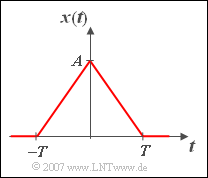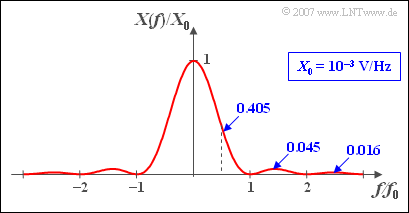Difference between revisions of "Aufgaben:Exercise 3.1Z: Spectrum of the Triangular Pulse"
From LNTwww
m (Text replacement - "Category:Exercises for Signal Representation" to "Category:Signal Representation: Exercises") |
|||
| Line 3: | Line 3: | ||
}} | }} | ||
| − | [[File:P_ID493__Sig_Z_3_1_neu.png|right|frame| | + | [[File:P_ID493__Sig_Z_3_1_neu.png|right|frame|Triangular pulse]] |
A triangular pulses ${x(t)}$, is considered, which is described in the range $–T ≤ t ≤ T$ by the following equation: | A triangular pulses ${x(t)}$, is considered, which is described in the range $–T ≤ t ≤ T$ by the following equation: | ||
:$$x(t) = A \cdot \left( {1 - {\left| \hspace{0.05cm}t \hspace{0.05cm}\right|}/{T}} \right).$$ | :$$x(t) = A \cdot \left( {1 - {\left| \hspace{0.05cm}t \hspace{0.05cm}\right|}/{T}} \right).$$ | ||
| Line 25: | Line 25: | ||
''Hints:'' | ''Hints:'' | ||
*This exercise belongs to the chapter [[Signal_Representation/Fourier_Transform_and_Its_Inverse|Fourier Transform and Its Inverse]]. | *This exercise belongs to the chapter [[Signal_Representation/Fourier_Transform_and_Its_Inverse|Fourier Transform and Its Inverse]]. | ||
| − | *Further information on this topic can be found in the learning video [[Kontinuierliche_und_diskrete_Spektren_(Lernvideo)| | + | *Further information on this topic can be found in the learning video [[Kontinuierliche_und_diskrete_Spektren_(Lernvideo)|Continuous and discrete spectra]]. |
| − | * | + | *You can use the following formulas to solve this task: |
:$$\int {t \cdot \cos \left( {\omega _0 t} \right)\ {\rm d}t = \frac{{\cos \left( {\omega _0 t} \right)}}{\omega _0 ^2 }} + \frac{{t \cdot \sin \left( {\omega _0 t} \right)}}{\omega _0 }, \hspace{0.5cm} \sin ^2 \left( \alpha \right) = {1}/{2} \cdot \left( {1 - \cos \left( {2\alpha } \right)} \right).$$ | :$$\int {t \cdot \cos \left( {\omega _0 t} \right)\ {\rm d}t = \frac{{\cos \left( {\omega _0 t} \right)}}{\omega _0 ^2 }} + \frac{{t \cdot \sin \left( {\omega _0 t} \right)}}{\omega _0 }, \hspace{0.5cm} \sin ^2 \left( \alpha \right) = {1}/{2} \cdot \left( {1 - \cos \left( {2\alpha } \right)} \right).$$ | ||
| Line 73: | Line 73: | ||
'''(2)''' With the trigonometric transformation ${1}/{2} \cdot (1 - \cos (2 \alpha)) = \sin^2(\alpha)$ one obtains for the spectral function: | '''(2)''' With the trigonometric transformation ${1}/{2} \cdot (1 - \cos (2 \alpha)) = \sin^2(\alpha)$ one obtains for the spectral function: | ||
| − | [[File:P_ID497__Sig_Z_3_1_d_neu.png|right|frame|$\rm si$- | + | [[File:P_ID497__Sig_Z_3_1_d_neu.png|right|frame|Spectrum of $\rm si$-squared]] |
:$$X(f) = A \cdot T \cdot \frac{\sin^2(\pi f T)}{\pi^2 \cdot {f^2 \cdot T^2}} = A \cdot T \cdot {{{\rm si}^2(\pi f T)}}.$$ | :$$X(f) = A \cdot T \cdot \frac{\sin^2(\pi f T)}{\pi^2 \cdot {f^2 \cdot T^2}} = A \cdot T \cdot {{{\rm si}^2(\pi f T)}}.$$ | ||
*At the frequency $f = 0$ the $\rm si$-function is equal to $1$. From this follows: | *At the frequency $f = 0$ the $\rm si$-function is equal to $1$. From this follows: | ||
Revision as of 14:17, 26 March 2021
A triangular pulses ${x(t)}$, is considered, which is described in the range $–T ≤ t ≤ T$ by the following equation:
- $$x(t) = A \cdot \left( {1 - {\left| \hspace{0.05cm}t \hspace{0.05cm}\right|}/{T}} \right).$$
Let the pulse amplitude be $A = 1\, \text{V}$, the time parameter $T = 1 \text{ ms}$. For all times $|\hspace{0.05cm} t \hspace{0.05cm} | > T$ ist ${x(t)} = 0$.
To calculate the spectral function ${X(f)}$ you can exploit the following properties:
- The time function is even and thus the spectral function is real:
- $$X\left( f \right) = \int_{ - \infty }^{ + \infty } {x(t)} \cdot {\rm e}^{{\rm j}2\pi ft} {\rm d}t = 2 \cdot \int_0^{ \infty } {x(t)} \cdot \cos \left( {2\pi ft} \right){\rm d}t.$$
- For $|\hspace{0.05cm} t \hspace{0.05cm} | > T$, ${x(t)}$ has no components:
- $$X\left( f \right) = 2 \cdot \int_0^T {x(t)} \cdot \cos \left( {2\pi ft} \right){\rm d}t.$$
Hints:
- This exercise belongs to the chapter Fourier Transform and Its Inverse.
- Further information on this topic can be found in the learning video Continuous and discrete spectra.
- You can use the following formulas to solve this task:
- $$\int {t \cdot \cos \left( {\omega _0 t} \right)\ {\rm d}t = \frac{{\cos \left( {\omega _0 t} \right)}}{\omega _0 ^2 }} + \frac{{t \cdot \sin \left( {\omega _0 t} \right)}}{\omega _0 }, \hspace{0.5cm} \sin ^2 \left( \alpha \right) = {1}/{2} \cdot \left( {1 - \cos \left( {2\alpha } \right)} \right).$$
Questions
Solution
(1) Taking advantage of the above symmetry properties, the abbreviation $\omega = 2\pi f$ holds:
- $$X(f) = 2A \cdot \int_0^T {\left( {1 -{t}/{T}} \right)} \cdot \cos \left( {\omega t} \right)\hspace{0.1cm}{\rm d}t.$$
- This integral is composed of two parts:
- $$X_1 (f) = 2A \cdot \int_0^T {\cos } \left( {\omega t} \right)\hspace{0.1cm}{\rm d}t = \frac{2A}{\omega } \cdot \sin \left( {\omega T} \right),$$
- $$X_2 (f) = - \frac{2A}{T} \cdot \int_0^T {t \cdot \cos } \left( {\omega t} \right)\hspace{0.1cm}{\rm d}t = - \frac{2A}{T} \cdot \left. {\left[ {\frac{{\cos \left( {\omega t} \right)}}{\omega ^2 } + \frac{{t \cdot \sin \left( {\omega t} \right)}}{\omega }} \right]} \right|_0^T .$$
- Taking into account the upper and lower limits, one obtains:
- $$X_2 \left( f \right) = - \frac{2A}{T} \cdot \left[ {\frac{{\cos \left( {\omega T} \right)}}{\omega ^2 } - \frac{1}{\omega ^2 } + \frac{{T \cdot \sin \left( {\omega T} \right)}}{\omega }} \right].$$
- Adding the two parts, we get:
- $$X(f) = \frac{2A}{\omega ^2 \cdot T}\cdot \big[ {1 - \cos \left( {\omega T} \right)} \big] = \frac{A}{2\pi ^2 f^2 T} \cdot \big[ {1 - \cos \left( {2\pi fT} \right)} \big].$$
- At frequency $f = 1/(2T) = 500 \,\text{Hz}$ the argument of the cosine function is equal to $\pi$ and the cosine function itself is equal to $-1$. It follows:
- $$X( {f ={1}/{2T} = 500\;{\rm Hz}} ) = \frac{4}{\pi^2} \cdot A \cdot T = \frac{4}{\pi^2} \cdot 1\;{\rm V} \cdot 10^{ - 3}\;{\rm s}\hspace{0.15 cm}\underline{= 0.405 \,{\rm mV/Hz}}.$$
(2) With the trigonometric transformation ${1}/{2} \cdot (1 - \cos (2 \alpha)) = \sin^2(\alpha)$ one obtains for the spectral function:
- $$X(f) = A \cdot T \cdot \frac{\sin^2(\pi f T)}{\pi^2 \cdot {f^2 \cdot T^2}} = A \cdot T \cdot {{{\rm si}^2(\pi f T)}}.$$
- At the frequency $f = 0$ the $\rm si$-function is equal to $1$. From this follows:
- $$X( {f = 0} ) = A \cdot T \hspace{0.15 cm}\underline{= 1\,{\rm mV/Hz}}.$$
(3) The first zero occurs when the argument of the si function is equal to $\pi$ .
- From this follows $f_0 \cdot T = 1$ bzw. $f_0 = 1/T \hspace{0.15 cm}\underline{= 1 \ \text{kHz}}$.
(4) The first statement is correct:
- The spectrum ${X(f)}$ is equal to ${\rm si}^2(n \cdot \pi) = 0$ at multiples of $f_0$ $(f = n \cdot f_0)$ .
- The second statement is false: At no frequency $f$ is ${X(f)} < 0$ (see sketch).

